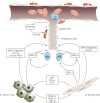Therapeutic options targeting angiogenesis in nonsmall cell lung cancer
- PMID: 24591665
- PMCID: PMC9487252
- DOI: 10.1183/09059180.00008913
Therapeutic options targeting angiogenesis in nonsmall cell lung cancer
Abstract
There is a major unmet medical need for effective and well-tolerated treatment options for patients with advanced nonsmall cell lung cancer (NSCLC), in both first-line and relapsed/refractory settings. Experimental evidence has validated signalling pathways that regulate tumour angiogenesis, including the vascular endothelial growth factor (VEGF), platelet-derived growth factor (PDGF) and fibroblast growth factor (FGF) pathways, as valid anti-cancer drug targets. However, to date, bevacizumab (an anti-VEGF monoclonal antibody) is the only antiangiogenic agent to be approved for the treatment of NSCLC. Many other agents, including antibodies, small-molecule tyrosine kinase inhibitors and vascular disrupting agents, have been assessed in phase III trials but have generally failed to demonstrate clinically meaningful benefits. This lack of success probably reflects the redundancy of proangiogenic pathways and the molecular and clinical heterogeneity of NSCLC. In this review we summarise recently completed and ongoing randomised clinical trials of emerging antiangiogenic agents in patients with NSCLC. We highlight recent promising data with agents that simultaneously inhibit multiple proangiogenic pathways, including the PDGF and FGF pathways, as well as the VEGF pathway. Finally, we discuss the outlook for antiangiogenic agents in NSCLC, emphasising the need for clinically validated prognostic and predictive biomarkers to identify patients most likely to respond to therapy.
Conflict of interest statement
Conflict of interest: None declared.
Figures

Similar articles
-
Targeting angiogenesis in squamous non-small cell lung cancer.Drugs. 2014 Mar;74(4):403-13. doi: 10.1007/s40265-014-0182-z. Drugs. 2014. PMID: 24578213 Free PMC article. Review.
-
Antiangiogenic therapy in nonsmall cell lung cancer.Curr Opin Oncol. 2008 Mar;20(2):176-82. doi: 10.1097/CCO.0b013e3282f4e55e. Curr Opin Oncol. 2008. PMID: 18300767 Review.
-
Emerging angiogenesis inhibitors for non-small cell lung cancer.Expert Opin Emerg Drugs. 2019 Jun;24(2):71-81. doi: 10.1080/14728214.2019.1619696. Epub 2019 May 22. Expert Opin Emerg Drugs. 2019. PMID: 31092048 Review.
-
Angiogenesis inhibitors and vascular disrupting agents in non-small cell lung cancer.Curr Med Chem. 2009;16(30):3919-30. doi: 10.2174/092986709789352286. Curr Med Chem. 2009. PMID: 19747132 Review.
-
Antiangiogenic agents in the treatment of nonsmall cell lung cancer: reality and hope.Curr Opin Oncol. 2010 Mar;22(2):79-85. doi: 10.1097/CCO.0b013e328335a583. Curr Opin Oncol. 2010. PMID: 20009926 Review.
Cited by
-
IL-17 Promotes Angiogenic Factors IL-6, IL-8, and Vegf Production via Stat1 in Lung Adenocarcinoma.Sci Rep. 2016 Nov 7;6:36551. doi: 10.1038/srep36551. Sci Rep. 2016. PMID: 27819281 Free PMC article.
-
The impact of previous therapy strategy on the efficiency of anlotinib hydrochloride as a third-line treatment on patients with advanced non-small cell lung cancer (NSCLC): a subgroup analysis of ALTER0303 trial.Transl Lung Cancer Res. 2019 Oct;8(5):575-583. doi: 10.21037/tlcr.2019.09.21. Transl Lung Cancer Res. 2019. PMID: 31737494 Free PMC article.
-
Different types of tumor microvessels in stage I-IIIA squamous cell lung cancer and their clinical significance.World J Clin Oncol. 2024 May 24;15(5):614-634. doi: 10.5306/wjco.v15.i5.614. World J Clin Oncol. 2024. PMID: 38835849 Free PMC article.
-
Novel active agents in patients with advanced NSCLC without driver mutations who have progressed after first-line chemotherapy.ESMO Open. 2017 Jan 13;1(6):e000118. doi: 10.1136/esmoopen-2016-000118. eCollection 2016. ESMO Open. 2017. PMID: 29435365 Free PMC article.
-
Platelet derived growth factor inhibitors: A potential therapeutic approach for ocular neovascularization.Saudi J Ophthalmol. 2015 Oct-Dec;29(4):287-91. doi: 10.1016/j.sjopt.2015.05.005. Epub 2015 Jun 6. Saudi J Ophthalmol. 2015. PMID: 26586980 Free PMC article. Review.
References
-
- American Cancer Society. Non-small cell lung cancer survival rates by stage. www.cancer.org/cancer/lungcancer-non-smallcell/detailedguide/non-small-c... Date last updated: July 12, 2013. Date last accessed: October 2013.
-
- Peters S, Adjei AA, Gridelli C, et al. . Metastatic non-small-cell lung cancer (NSCLC): ESMO Clinical Practice Guidelines for diagnosis, treatment and follow-up. Ann Oncol 2012; 23: Suppl. 7, vii56 vii64. - PubMed
-
- Sculier JP, Moro-Sibilot D. First- and second-line therapy for advanced nonsmall cell lung cancer. Eur Respir J 2009; 33: 915–930. - PubMed
-
- Shepherd FA, Dancey J, Ramlau R, et al. . Prospective randomized trial of docetaxel versus best supportive care in patients with non-small-cell lung cancer previously treated with platinum-based chemotherapy. J Clin Oncol 2000; 18: 2095–2103. - PubMed
Publication types
MeSH terms
Substances
LinkOut - more resources
Full Text Sources
Other Literature Sources
Medical
